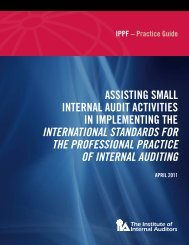2011 State of the Internal Audit Profession Study - PwC
2011 State of the Internal Audit Profession Study - PwC
2011 State of the Internal Audit Profession Study - PwC
You also want an ePaper? Increase the reach of your titles
YUMPU automatically turns print PDFs into web optimized ePapers that Google loves.
Figure 2. Indicate whe<strong>the</strong>r <strong>the</strong> level <strong>of</strong> focus in <strong>the</strong> audit plan for <strong>the</strong> following activities<br />
will increase or decrease in <strong>the</strong> next three years.<br />
Increase<br />
Decrease<br />
New information technology systems<br />
or process/control environments<br />
Process improvement/<br />
operational efficiency/cost reductions<br />
Enterprise risk<br />
management programs<br />
Strategic initiatives<br />
and programs<br />
Operational controls,<br />
ethics and compliance<br />
Existing information<br />
technology controls<br />
Regulatory<br />
compliance programs<br />
International<br />
locations<br />
Investigations<br />
90% 82% 79% 78% 73% 63% 60% 57% 47% 38%<br />
10% 18% 21% 22% 27% 37% 40% 43% 53% 62%<br />
SOX/Financial<br />
reporting<br />
whe<strong>the</strong>r management, <strong>the</strong> audit<br />
committee, and internal audit have<br />
a common understanding <strong>of</strong> <strong>the</strong><br />
time line to achieve mature country<br />
control standards.<br />
• Consolidating issues from audits<br />
in emerging markets in regular<br />
executive reports to ensure common<br />
<strong>the</strong>mes are understood, communicated,<br />
and addressed across<br />
geographic boundaries.<br />
Emerging markets<br />
The prospect <strong>of</strong> new growth in<br />
emerging markets is enticing to businesses<br />
in a wide range <strong>of</strong> industries.<br />
Our discussions with leading internal<br />
auditors confirmed a strategy to direct<br />
disproportionately more audit attention<br />
to <strong>the</strong>se higher risk locations<br />
than <strong>the</strong>ir size or materiality would<br />
o<strong>the</strong>rwise warrant. Primary areas<br />
<strong>of</strong> focus within <strong>the</strong>se high-risk locations<br />
included order to cash, treasury,<br />
procurement, capital expenditures, and<br />
regulatory compliance.<br />
To help <strong>the</strong>ir companies address <strong>the</strong><br />
risks associated with emerging market<br />
expansion, leading internal audit organizations<br />
are taking actions such as:<br />
• Facilitating emerging risk discussions<br />
with <strong>the</strong> executive team<br />
and <strong>the</strong> audit committee. Making<br />
growth in emerging markets and <strong>the</strong><br />
associated risks a prominent audit<br />
committee agenda item. Considering<br />
political stability, cultural differences,<br />
regulatory environment, and<br />
availability <strong>of</strong> competent resources<br />
in performing country-specific<br />
risk assessments.<br />
• Getting involved early in <strong>the</strong><br />
development stage to establish a<br />
strong system <strong>of</strong> internal controls.<br />
Assessing whe<strong>the</strong>r policies and<br />
procedures at <strong>the</strong> local level appropriately<br />
balance <strong>the</strong> objectives <strong>of</strong>:<br />
consistency with corporate standards<br />
and values; local laws, regulations,<br />
and accounting standards;<br />
and practicality and sustainability in<br />
<strong>the</strong> local culture.<br />
• Using detailed data analytics to<br />
remotely plan location audits <strong>the</strong>reby<br />
sharpening audit focus, shortening<br />
<strong>the</strong>ir duration and making it possible<br />
for more audits to be performed.<br />
• Working with management to<br />
develop targets and recommended<br />
actions to achieve acceptable control<br />
environments for operations located<br />
in emerging markets. Determining<br />
• Becoming knowledgeable about<br />
<strong>the</strong> US Foreign Corrupt Practices<br />
Act (FCPA), <strong>the</strong> UK’s Bribery Act<br />
and o<strong>the</strong>r relevant anticorruption<br />
standards. Making that knowledge<br />
relevant to management and <strong>the</strong><br />
audit committee by showing how it<br />
can affect planned growth strategies<br />
in emerging markets.<br />
• Building local or regional satellite<br />
functions and partnering with o<strong>the</strong>r<br />
risk and compliance functions to<br />
develop local knowledge <strong>of</strong> business<br />
practices, regulatory standards,<br />
and culture—all <strong>of</strong> which is critical<br />
to successfully navigating <strong>the</strong> risk<br />
environment. Leading internal audit<br />
organizations establish international<br />
co-sourcing arrangements to expand<br />
geographic reach and capabilities to<br />
better identify and audit risks.<br />
• Playing a primary role in monitoring<br />
risks through regular and ongoing<br />
site visits; <strong>of</strong>fsite reviews <strong>of</strong> significant<br />
financial and operating metrics;<br />
participating in delivery <strong>of</strong> training<br />
programs; and interacting regularly<br />
with company leadership at <strong>the</strong><br />
corporate, regional, and local levels.<br />
7


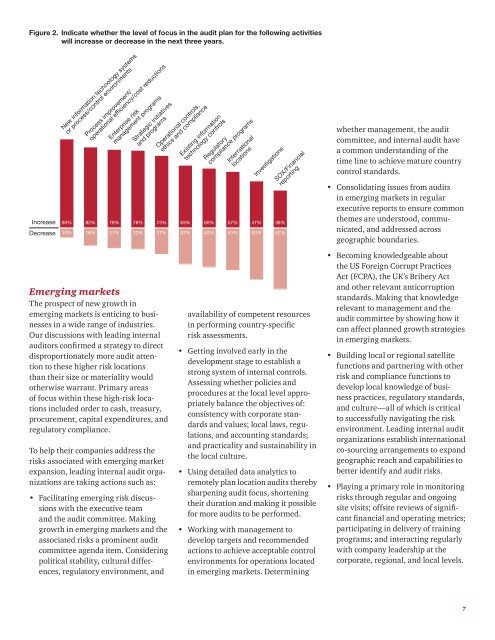
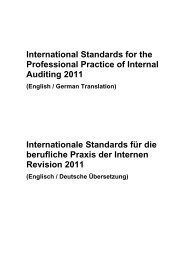

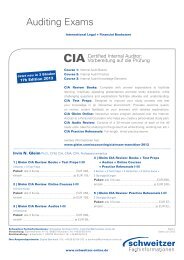
![Ausgabe 02_2011 [PDF, 3.4 MB] - Institut für Interne Revision ...](https://img.yumpu.com/37945857/1/184x260/ausgabe-02-2011-pdf-34-mb-institut-fa-1-4-r-interne-revision-.jpg?quality=85)
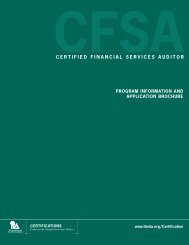
![Ausgabe 2004.2 [PDF, 1.1 MB] - Institut für Interne Revision Ãsterreich](https://img.yumpu.com/37941871/1/184x260/ausgabe-20042-pdf-11-mb-institut-fa-1-4-r-interne-revision-asterreich.jpg?quality=85)
![Ausgabe 02_2009 [PDF, 1.2 MB] - Institut für Interne Revision ...](https://img.yumpu.com/37941824/1/184x260/ausgabe-02-2009-pdf-12-mb-institut-fa-1-4-r-interne-revision-.jpg?quality=85)
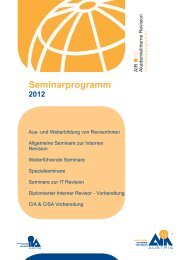
![Ausgabe 03_2011 [PDF, 9.1 MB] - Institut für Interne Revision ...](https://img.yumpu.com/37941423/1/184x260/ausgabe-03-2011-pdf-91-mb-institut-fa-1-4-r-interne-revision-.jpg?quality=85)
![Ausgabe 2006.2 [PDF, 852.7 KB] - Institut für Interne Revision ...](https://img.yumpu.com/37941416/1/184x260/ausgabe-20062-pdf-8527-kb-institut-fa-1-4-r-interne-revision-.jpg?quality=85)
![Ausgabe 03_2007 [PDF, 1.5 MB] - Institut für Interne Revision ...](https://img.yumpu.com/37941405/1/184x260/ausgabe-03-2007-pdf-15-mb-institut-fa-1-4-r-interne-revision-.jpg?quality=85)
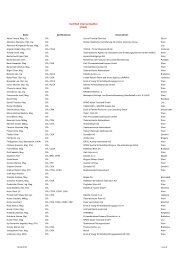
![CEE Konferenzprogramm [PDF, 11.8 MB] - Institut für Interne ...](https://img.yumpu.com/37941387/1/184x260/cee-konferenzprogramm-pdf-118-mb-institut-fa-1-4-r-interne-.jpg?quality=85)
